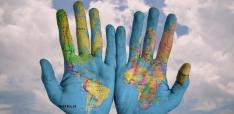The ‘New’ New Development Bank: A Decade Plus in the Making

Gregory T. Chin argues that the NDB's second decade will be shaped by how it navigates a world of worsening geopolitical and geo-economic tensions between rival superpowers.
When much of the world shut-down at the height of the COVID-19 pandemic, in late 2021, the New Development Bank (NDB) welcomed four nations into its membership, Bangladesh, the United Arab Emirates, Uruguay and Egypt. These additions, with Uruguay pending, were the first new members since the creation of the Bank by its founding members, the BRICS nations of Brazil, Russia, India, China and South Africa.
The expansion of the NDB did not make global news headlines, but it was noticed by scholars and informed insiders who track global development and multilateral development banking – including those at a webinar discussion hosted by the Boston University Global Development Policy Center in October 2021.
At a minimum, the addition of new members to the NDB called attention to the fact there is more going on than BRICS-skeptics have suggested.
Why are nations joining the NDB or the BRICS? This is especially curious amid increased pressure by Western alliances for developing countries to align with them, rather than with the BRICS.
In March 2022, an interdisciplinary group of social scientists gathered around Global Policy journal to discuss and research what the NDB additions mean, the motivations for new member states in joining, the interests of the Bank and the founding members, as well as other recent changes in the NDB’s organizational structure, the Bank’s agenda and policy, its positioning with other multilateral development banks (MDBs) and the policy implications surrounding the expansion of the Bank.
Answering these fundamentals requires figuring out what is ‘new’ or different about the NDB since its inception.
A new special section of journal articles published by Global Policy explores the evolution and expansion of the NDB and the BRICS. The collection of 10 articles from esteemed scholars around the globe explores the evolution of the NDB and its role in the global financial architecture, the unique characteristics of the NDB’s governance as compared with other MDBs, the rationale and impacts of adding new members and increasing multipolarity, and the NDB’s organizational evolution.
The evolution of the NDB and its positioning in the global financial architecture
The introductory article by the Editor for the Special Section and the culminating article by former senior World Bank and NDB officials and scholars Bert Hofman and P.S. Srinivas, assess patterns of continuity and change in the nature of the NDB in comparison with traditional MDBs, finding that the BRICS-led Bank shares some attributes, purposes and goals of the other MDBs, but also exhibits some new or differing characteristics, norms and values.
The Introductory article highlights the key contributions of each article in the Special Section, and discusses the achievements of the NDB during its first decade, the evolving scholarly debates and research agendas on the NDB, and the subtle shifts in the focus, goals and agenda of the Bank, from its initial establishment to the current period as the NDB enters its second decade.
Hofman and Srinivas highlight that the NDB is not a ‘rogue’ actor, working completely off-grid, aiming to catalyze a rapid and radical transformation, great leap-style. Despite some of the rhetoric of the founders at the Bank’s creation, Hofman and Srinivas point out that the Bank is operating within the established terrain of the existing MDBs in that one of NDB’s “most critical challenges” is to scale up its lending and operations, and it must do so while competing with other multilateral and bilateral lenders.
Interestingly, Hofman and Srinivas further suggest that the decision to keep staffing to a minimum means that the NDB may be less ambitious than the established MDBs.
Chin sees the NDB as having more ambition than the established MDBs in some respects, such as in using local currency and for green bonds, but less ambition, for example, in building the NDB’s own in-house research and policy influence capacity, in comparison to the World Bank and ADB. The NDB founders (the BRICS governments) decided to avoid investing heavily in becoming a ‘Knowledge Bank’, as the World Bank aspires to be, offering policy advice to its loan recipients.
Nonetheless, the decision, heretofore, to stick to this strategic position – i.e. avoid building the NDB’s policy research and influence capacities – is proving to be detrimental to the medium-term development and global influence of the Bank and its membership, and to their efforts in sustaining the global developmental push from the Global South, of advancing a Southern-led development agenda. Attention is now being put onto whether and how the NDB should enhance its research agenda and research capabilities, its global policy engagement and become more active within global development policy debates, in order to share its unique experiences and lessons learned.
What makes the NDB governance and agenda unique
The NDB stands out among the MDBs as the one created by, led by and for emerging and developing countries; and where the founding emerging and developing members also currently have equal financial contributions and equal voice. Additionally, no member alone has a veto power, in contrast to legacy MDBs, such as the World Bank, where advanced economies usually hold majority decision-making power.
Regarding the NDB’s other unique governance norms, Hofman and Srinivas further highlight the emergence of high-level strategic decisions made by “greater agreement, if not consensus” as precedence, and the preordered-rotating presidency and vice presidencies among the founders as elemental.
In his contribution, Zhu Jiejin delves into how the principle of ‘equal contribution/voice of the founding members’ combined with the norm of ‘agreement by consensus’ has actually resulted in tensions between founding members, and how China has turned to increasing multilateralism (membership expansion) as the preferred option for mitigating these tensions.
Chin’s introduction details how and why, during the first five-year period of the Bank (2016-2021), member states and senior management pushed and positioned the Bank, first, to do ‘new’ things in three respects: (a) launch new projects that promoted ‘sustainability’, both ‘sustainable infrastructure’ and ‘sustainable development’ projects; (b) focus the Bank squarely on renewables, and with a quantified pledge of earmarking up to 60 percent of lending for renewable energy (these were self-conscious decisions knowing NDB was one-of-two new MDBs, along with the Asian Infrastructure Investment Bank, created after the Paris Agreement); and (c) support local currency use, as a ‘financial sustainability’ strategy.
Secondly, the NDB pledged to ‘move with speed,’ be rapid in responding to the proposals from its members. Relatedly, the Bank also committed to using local environmental and social standards in an effort to avoid applying policy conditionality on its Southern borrowers.
Third, the NDB committed to undertaking innovation that entailed a higher level of risk appetite than the legacy MDBs, and to reconceptualizing (credit) risk and mitigation. In addition to the aforementioned innovations, Hofman and Srinivas further identify a lean management and staff structure, and using the most advanced and evolving technology for its operations as the NDB’s main operational innovations as other ways the Bank has consciously attempted to differentiate itself from the established MDBs.
These elements have emerged as signature features of the NDB and are said to reflect the Bank’s commitment and dedication to a rising ‘Southern multilateral’ agenda, or ‘new Southern multilateralism’ as supported by the BRICS.
Adding new members and increasing multipolarity
Next, Chris Alden and Garth le Pere explore the Southern developmental roots of the NDB in the Southern collective diplomacy agenda of the India, Brazil and South Africa (IBSA) grouping, which preceded the BRICS as a self-conscious cooperative grouping. They also consider the global shift to multipolarity, and the emerging importance of regional options for the NDB, and for the BRICS nations, focusing specifically on South Africa within Africa, India and South Asia, and Brazil and South America, and the possible interconnections between regional trade integration and the NDB’s regional offices.
The theme of adding members to the NDB immediately raises the issue of purpose. For this collection, Jim O’Neill returns to the theme of the ‘BRICs’, the term he coined (South Africa was not included in O’Neill’s original formulation, which was focused on Brazil, Russia, India and China). Similar to the question of BRICS expansion, O’Neill emphasizes the importance of figuring out criteria and procedures for NDB membership expansion; the need to reach consensus on the criteria for admission, linking them to a redefinition of collective purposes and specific goals; a clearly defined scope of activity, and value-added, for their future collective action. O’Neill suggests that the 2023 addition of the main petrostates in the Gulf and Middle East to the NDB membership would be useful for supporting the Bank’s drive for more local currency use.
Other articles in the Special Section examine the details and consequences of the respective accessions of the UAE, Uruguay and Bangladesh to the NDB.
In our contribution, Rifat D. Kamal and I examine the case of Bangladesh, the first “borrowing member” to join the NDB. Drawing on Kamal’s extensive field interviews, we detail Bangladesh’s relative fast and smooth accession, the specific national developmental motivations behind their decision to join, and its experience and results since joining. We highlight the delays in finalizing project loans with the NDB, and the factors behind, and considerations involved.
Separately, Andrew F. Cooper and Brendon J. Cannon analyze the UAE, the first “non-borrowing member” and first developed high-income country to join. Based on their ground-breaking field work, they analyze the UAE’s national interests and foreign policy considerations in joining the NDB, the unique contributions that the UAE can make to the Bank, both financial and beyond, and highlight how joining the NDB is one component of the UAE’s forward-looking and proactive strategy for balancing its positive relations with the West and its growing relations with the BRICS and Asia.
Alvaro Mendez conducted pioneering fieldwork on the motivations and logic behind Uruguay’s decision to seek NDB membership, a case of accession that has involved the proactive and effective interventions of the senior diplomats from this South American nation, as well as the determined support from Brazil and within the Bank. The delay in Uruguay’s accession has left observers wondering why Uruguay is still a “prospective member” and what is standing in the way of Uruguay passing the formal legislation to join, and depositing its financial contribution.
The NDB’s organizational evolution
In addition to the country studies, the Special Section addresses two other important dimensions of the NDB’s organizational evolution that deserve more attention from researchers.
The first is the establishment of regional offices in key regions around the world. The NDB has been expanding its regional footprint in the various regions of the BRICS countries, opening regional offices starting in Africa in 2017, South America in 2019, Eurasia in 2020 and most recently, South Asia in 2022. In their contribution, Daniel Bradlow and Magalie Masamba, former Global China Post-Doctoral Research Fellow, offer a penetrating “mid-term evaluation” of the NDB in Africa and its African Regional Centre (ARC). They find that the results to date are somewhat underwhelming. In his piece, Mendez addresses the early days and potential role of the NDB’s Americas Regional Office (ARO).
The second dimension involves the NDB’s strategic outreach and partnership-building. In their contribution, former Asian Development Bank official and scholar Suresh Nanwani details the NDB’s unique approach to outreach and partnership-building and assesses the successes and challenges encountered on the path to implementation, including how geopolitical factors have constrained the Bank’s partnership and outreach opportunities with other major MDBs. Nanwani, alongside my introduction, respectively discuss how geopolitics have forced the NDB to devise innovative solutions to provide financing to member countries facing US and EU sanctions, like Russia.
Ultimately, it is fair to debate whether the NDB members and senior management have been daring enough in building-up the Bank, given the initial vision of the BRICS governments when launching the NDB – in building its global profile and presence, in pursuing alternative ways of doing things that support a Southern developmental agenda: whether on membership expansion, regional offices, outreach and partnership, or on the tangible goals of promoting local currency use, tackling climate change and environmental protection, as well as promoting sustainable infrastructure and renewable energy.
China, for one, has been hoping the NDB could and would be more ambitious in expanding its international profile, especially by supporting the Belt and Road Initiative (BRI).
However, as Zhu Jiejin details in his article, Beijing ran into roadblocks inside the NDB, from New Delhi, on the one hand, when China attempted to get the Bank to support BRI-related work, and on the other hand, as the Bank and Beijing have been hamstrung by US and EU financial sanctions against Russia. Whereas one may have expected China to have pushed the Bank to do more, faster and be more ambitious and impactful, for example on supporting BRI projects, or to increase the NDB’s use of local currencies, the contestation with India and the West has meant that Beijing has had to be more cautious, and avoid pushing the NDB to do things in ways that would upset some founding members or lead to sanctions. But the cost of taking the approach of limited risk has been limited reward for the NDB, Beijing, the BRICS and now the BRICS Plus.
Zhu suggests that China, by supporting NDB membership expansion, is not seeking to create veto power for itself, as many assume; rather, China is seeking to advance the Bank as a model of “true multilateralism.” Additionally, he argues that China is seeking to mitigate some of the geopolitical constraints that are hobbling the Bank, by adding more stakeholders to the negotiating table, and by diluting or diminishing the influence or effects of some of the other founding members within the Bank through expanded multilateralism.
The emerging future for the NDB
The arrival of Dilma Rousseff as NDB President in Spring 2023 has coincided with the return to a more ambitious agenda for the Bank. The ‘new’ President is pushing the Bank to support not only sustainability, but also Brazilian-inspired ‘inclusive growth.’ The latter draws on the experience of Brazil under Presidents Lula da Silva and Rousseff. She is also pushing the NDB to support the development of African countries, pursue more local currency use, as well as build a broader international profile, expand the institutional footprint and organizational reach of the Bank through member expansion, and offer better and more strategic outreach and partnerships.
President Rousseff has kept the focus on climate change mitigation, though one could argue that the NDB has seen a scaling back of its ambition in the climate area prior to her arrival. In the NDB’s latest five-year strategy (2022-2026), the Bank has ear-marked 40 percent of its project financing to renewables, whereas in the previous five-year period (2017-2021), the Bank had put the target at 60 percent. Considering that the current 40 percent target would still be an increase in the total amount of financing dedicated to renewables given the increases in the Bank’s lending, it is worth debating whether the decrease in the relative percentage nonetheless signals diminished ambition and that the NDB should contribute even more to achieving the Paris Agreement goals.
As Elizabeth Sidiropoulos, head of the South African Institute of International Affairs, suggests, the NDB could make an even greater and more consistent commitment to supporting climate change mitigation and reversal, catalyzing a paradigm shift in world development, for example, by changing the framework for how credit risk is assessed, rather than supporting a business-as-usual approach.
In summary, during its first decade, the NDB completed the task of establishing the core foundations for a credible and legitimate MDB, and the Bank achieved several key milestones in its institutional formation. The main elements for sustained success and relevant innovation have been put in place. Entering its second decade, the world around the NDB has changed quite fundamentally from the time when the Bank was created.
The future of the NDB will be shaped significantly by how well its members can navigate a world of worsening geopolitical and geo-economic tensions between rival superpowers, including further weaponization of the established global trade and payments system and growing global economic uncertainty and instability. The NDB must do so while ‘scaling-up’ significantly, offering much more financing, and in innovative ways, building on its first decade. But the foremost challenge and arguably the most important goal, in the next decade, is achieving both while also continuing to advance new thinking and approaches to sustainability and inclusive development, including new institutional models that are inspired from its constituencies in the Global South.
This was originally published on the Boston University Global Development Policy Center.
Photo by Aleksandar Pasaric


